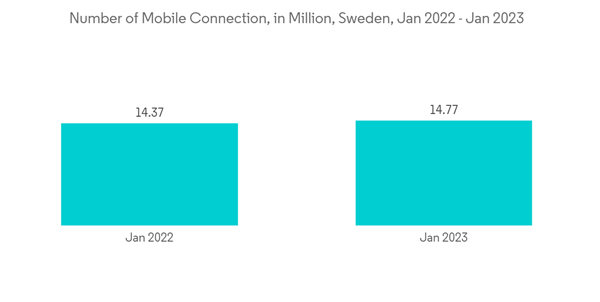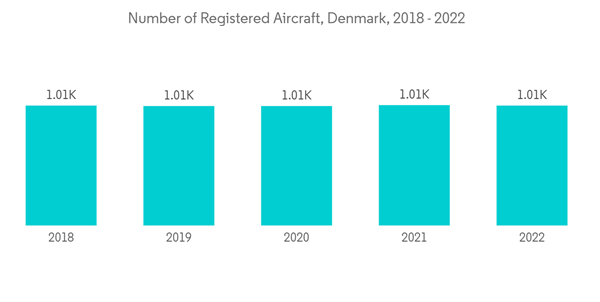Key Highlights
- Location-based services require much high-resolution data for both government and commercial usage. A vast constellation of satellites is required to cater to the increasing demand for these services. LBS providers offer services that are tailored to the needs of users. Hence, the global positioning system (GPS) is crucial in finding the locations. GPS is a worldwide satellite navigational system formed by a constellation of 24 Earth-orbiting satellites. Moreover, the need for LBS to function appropriately in challenging urban landscapes, such as between high-rise buildings, is increasing the desirability of multi-GNSS solutions that can access the information of more constellations to compensate for the restricted satellite visibility.
- With the rising number of commercial vehicles across the region, the need to manage vehicles is also increasing with the evolving technology. According to ACEA, in the European Union, demand for new commercial vehicles climbed by 24.0% to reach 1,292,628 units. In this period, demand for new light commercial vehicles in the EU remained strong (+23.6%). Moreover, the telematic systems being incorporated in vehicles allow the exchange of information via the integration of the Internet, offering better fleet tracking. Telematic systems consist of communication systems, with internet service provided for getting vehicle locations. Telematic systems in transportation control the fuel cost with enabled engine diagnostics and maintenance for real-time vehicle tracking.
- Health service and information providers can react immediately to the changed location of a mobile user by conveying personalized, timely information and services for the user's new roaming region. With the help of indoor mapping and navigation products, patients can be assisted in making their way to and through any healthcare facility. Real-time information can be conveyed to the patients depending on where they are in the hospital, allowing them to make appointments on time and find the correct testing area. Patient tracking is essential for more vulnerable patients, such as people with Alzheimer's or younger children. Patients can be located directly in an emergency to deliver care faster and more efficiently.
- On the contrary, location-based services are revolutionizing a variety of businesses where resource efficiency is crucial. The positions of individuals may be tracked at all times, and LBS gives the visibility needed to keep people safe. As a result, data security and privacy become increasingly important for users as misuse may result in disastrous consequences. The frequency of data breaches has risen considerably in recent years due to various applications defying restrictions to gain access to a user's location without their authorization. Google plans to implement a recent policy change requiring all app designers to undergo an authorization process before their apps collect the user's location information while running in the background.
- The negative impact garnered by the automotive sector was offset by the boom in e-commerce and the online retailing and FMCG sectors. Due to the global spread of COVID-19, the adoption of location-based services was expected to grow rapidly, owing to increased activity in the e-commerce sector. With the rise of homegrown brands and local players in these sectors, LBS helped companies gain significant traction from potential customers who are located near them, leveraging their close proximity.
Nordics Location-Based Services Market Trends
Indoor Location Segment is Expected to Hold a Significant Share of the Market
- Indoor LBS is gradually gaining traction due to the increasing penetration of smartphones, the development of sensor technology, and the increase in indoor time. Sensor technology has enabled smart networks to receive data from a smartphone without installing additional devices, making smartphones the most commonly used data source for indoor positioning. These sensors or hot spots are called Bluetooth Low Energy (BLE) beacons, which locate devices and users inside a building. Other kinds of indoor positioning being used by organizations are Wi-Fi and Geomagnetic. Thus, IT managers, marketing managers, facilities personnel, and other stakeholders are responsible for purchasing, installing, and maintaining these systems.
- Indoor tracking applications benefit indoor location tracking/positioning, proximity marketing, and real-time wayfinding for large facilities, such as airports, hospitals, stadiums, and convention centers. There is active research on designing and implementing an indoor positioning platform to sustain the development of future location-based 5G network functionalities and services.
- However, the built-in smartphone sensors' readings are easily affected by the surrounding environment and occasionally differ, adversely influencing indoor positioning accuracy. For instance, the built-in gyroscope sensor and the magnetometer sensor can be used to measure a user's heading direction, which may be different from each other and occasionally from themselves. As a result, this error accumulates, and the user's position may become increasingly inaccurate. Also, the reliability and availability of indoor positioning technologies, up-to-date indoor maps, and privacy considerations associated with location data are some of the biggest challenges to indoor LBS.
- In several cases, installation and integration services are highly prominent in the market, owing to increased customized and indoor LBS solutions. Installation of hardware and integration of custom technologies into locally deployed applications, etc., are some of the professional services growing faster in the market. The benefits also include training (on-site or offline), which is imparted to end users regarding the device's usage and its advantages. This is done after hardware and software integration.
- Data from GSMA Intelligence shows there were 14.77 million cellular mobile connections in Sweden at the start of 2023. GSMA Intelligence's numbers indicate that mobile connections in Sweden were equivalent to 139.6% of the total population in January 2023. Moreover, recently, Navenio, a provider of location-based services for indoor environments via mobile applications, secured a USD 1.1 million investment from Future Planet Capital to help revolutionize healthcare efficiency worldwide.
Transportation and Logistics is Expected to Hold Significant Share
- Location-based services find various applications in the transportation industry. In commercial transportation, these services are primarily used in autonomous vehicles or connected vehicles with intelligent devices and advanced features, like GPS and A-GPS, mainly used for location-based services like maps or navigation. In transportation, these services are also used for location-based information services, which include the localization of speed cameras, available parking spots, traffic alerts, and dynamic weather updates.
- Autonomous vehicles are gaining significant traction, with various multinational companies making strides in developing the required technologies. Many companies have also been identified as following this trend, which is expected to drive the adoption of autonomous vehicles over the period. Additionally, multinational technological firms, like Facebook, Apple Inc., Alphabet Inc., and Amazon, have been identified as spending heavily on developing AI-powered cars, further propelling the market growth.
- The advent of autonomous vehicles has also resulted in the rise of connected cars, whether vehicle-to-vehicle or vehicle-to-infrastructure, which is expected to augment the growth of the market studied. The navigational maps and live traffic information have been a powerful tool for the automotive industry. They are expected to be even more crucial now, with the vehicle connectivity requirement. The increased number of sensors included in modern vehicles, owing to the intro of advanced driver assistance systems, has prompted the vendors in the market to innovate their services. For example, HERE is a map and content player trying to include more information in maps.
- LBS also enables advanced fleet management services where one can remotely track every vehicle through GPS, monitor fuel economy and driver behavior, and gather valuable data to improve business efficiency (like ride-hailing services such as Uber and Lyft). With the increasing demand for supply chain visibility and transparency in the logistics industry, more businesses are empowering their fleet chains with GPS tracking technology. LBS helps integrate users with vehicle routes, stops, and driver schedules. An alert is triggered if the vehicle stops at an unregistered location or uses an unknown route.
- According to Statistics Denmark, as of January 1, 2022, 1,012 planes were recorded in the Scandinavian country. Such a huge number of aircraft would allow the market studied to grow. With the help of transponders installed on the aircraft, the satellite collects signals from the vessels to provide their position, route, speed, and ship type. Furthermore, platforms such as Google have improved ship tracking, allowing access to minute details of almost all ships within a location.
Nordics Location-Based Services Industry Overview
The Nordics location-based services (LBS) market exhibits a moderate level of consolidation, featuring several key players, including ALE International (Nokia Corporation), Cisco Systems Inc. (Cisco Meraki), Ericsson Inc., Esri Inc., and Aruba Networks (HPE Development LP). These companies are actively engaged in strategic partnerships and product development initiatives aimed at expanding their market presence.In April 2023, MetAlert Inc., a player in location-sensitive health monitoring devices and wearable technology products for remote patient monitoring, announced the launch of its new 4G GPS SmartSole in Denmark through its long-term distribution partner, Safecall Aps. The Safecall localizing platform has continued to develop through the years. It is now the market-leading platform in Denmark and Norway, used by thousands of healthcare professionals every day. The platform makes using different kinds of localizing equipment possible but with the same easy user interface each time.
In September 2022, a global player in precision measurement and workflow solutions, Topcon Positioning Group, reported the launch of Topnet Live in Finland, with the real-time GNSS network correction service now available for construction, agriculture, and mobility firms across the country. The new network offers users a full-constellation service, which uses all four GNSS satellite systems for greater accuracy and reliability. This includes Beidou and Galileo systems and the standard GLONASS and GPS.
Additional Benefits:
- The market estimate (ME) sheet in Excel format
- 3 months of analyst support
This product will be delivered within 2 business days.










